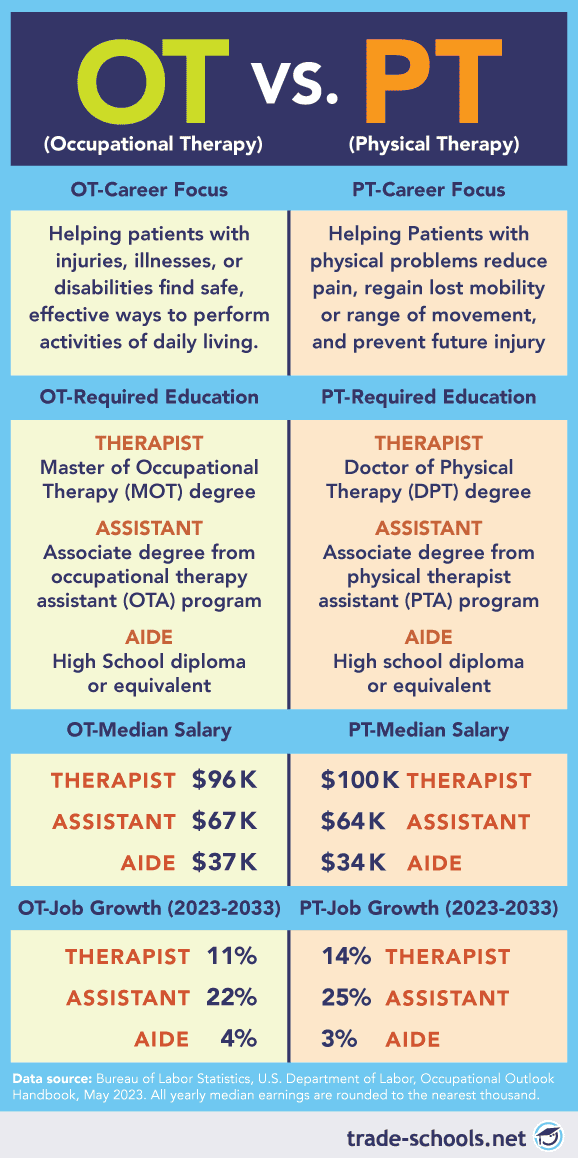Occupational Therapy vs. Physical Therapy: Choosing the Field That's Best for You
The choice of occupational therapy vs. physical therapy can be a little tricky for some career seekers to evaluate. How do you know which field is better? Here's step one: Read this article. And remember that the best choice for you will depend on your unique interests and goals.
Of course, understanding how these healthcare fields differ is essential. Although these two career areas are often confused with each other, they definitely have distinct focuses.
You're about to learn the key differences between occupational therapy and physical therapy with respect to aspects like salary potential, job duties, and required training. You'll also learn about working as a therapist, assistant, or aide in each field. Plus, you'll discover how to choose between careers like these.
- Physical therapy vs. occupational therapy: The main differences
- Physical therapists (PTs) and occupational therapists (OTs)
- Physical therapist assistants (PTAs) and occupational therapy assistants (OTAs)
- Physical and occupational therapy aides
- How to choose between these careers

Physical Therapy vs. Occupational Therapy: The Main Differences
 People who work in physical and occupational therapy share the same central goal: to improve their patients' lives. Regardless of their job title, these dedicated professionals strive to minimize the effects of injuries, illnesses, or other conditions on their patients' daily activities.
People who work in physical and occupational therapy share the same central goal: to improve their patients' lives. Regardless of their job title, these dedicated professionals strive to minimize the effects of injuries, illnesses, or other conditions on their patients' daily activities.
In fact, it's not unusual for a patient to see both a physical therapist (PT) and an occupational therapist (OT) as part of their treatment plan. That's because the work performed in these healthcare fields is often complementary.
But each field focuses on a separate aspect of a patient's well-being. Here's the key difference:
- Physical therapy focuses on treating physical restrictions. Treatments are centered on rehabilitating patients' bodies in order to help them move without pain or limitations.
- Occupational therapy focuses on helping patients find safe ways to perform the "occupations" of daily life. That often means finding ways to improve patients' environments in order to accommodate any physical restrictions or teaching them new ways to perform various activities.
For example, if a man injures one of his knees, a PT would work with him to rehabilitate the knee. And an OT would help him find ways to get the most out of life despite the injury. So if the injury prevented him from working, an OT could help determine which workplace accommodations may help him return to his job. If sports were a big part of his life, an OT could help him explore more knee-friendly activities.
Here's another example: If a woman is experiencing back pain caused by Parkinson's disease and can't get out of bed because the act of sitting up hurts too much, a physical therapist assistant (PTA) could help her learn how to do some exercises that ease the pain. And an occupational therapy assistant (OTA) might help her practice easier ways of getting out of bed.
So when it comes to physical vs. occupational therapy, here's a very condensed way to explain the differences: Physical therapy helps patients live with less pain and greater mobility. Occupational therapy helps them perform daily activities—as independently as possible.
Physical Therapists (PTs) and Occupational Therapists (OTs)
 These healthcare professionals evaluate patients, create treatment plans, and direct and supervise assistants and aides. Both occupations require extensive training. But beyond those similarities, the separate focuses make these different careers.
These healthcare professionals evaluate patients, create treatment plans, and direct and supervise assistants and aides. Both occupations require extensive training. But beyond those similarities, the separate focuses make these different careers.
Nature of the Work
The exact nature of physical therapists' work varies by specialty and patient. In general, physical therapists help people rehabilitate from conditions such as:
- Broken bones
- Strained muscles or tendons
- Sprained ligaments
- Joint dislocations
- Overuse injuries
- Amputations
- Movement difficulties caused by neurological problems like multiple sclerosis
- Physical difficulties arising from illnesses such as cancer or asthma
In treating these conditions, PTs aim to restore pain-free movement, improve range of motion, and prevent permanent disability. They also develop injury-prevention programs that include stretching and strengthening exercises. So physical therapy is a good career for people who are interested in body mechanics and want to use their knowledge to help others.
PTs typically work in settings such as:
- Private offices and clinics
- Hospitals
- Sports and training facilities
- Nursing homes
Occupational therapists often work with an even broader range of patients, including people with permanent disabilities. They even treat people who have mental or emotional difficulties that hold them back from participating in life's activities. For example, an occupational therapist could help a person with autism learn skills for independent living, such as how to take the bus. That's why occupational therapy is a good career for people who want to help patients gain greater overall freedom and well-being.
The focus of an OT's work is often on helping patients do the tasks that allow them to be active and independent. That means an occupational therapist does things like:
- Instructing patients how to use assistive devices such as wheelchairs
- Suggesting modifications to work environments that enable people with disabilities to perform their jobs
- Helping seniors and other people with physical restrictions maintain a safe living environment by identifying potential hazards, such as those that might cause falls
- Creating strategies for patients with physical or mental disabilities that enable them to perform activities of daily living such as bathing or getting dressed
- Assisting patients who have developmental difficulties with tasks like taking the bus or making a budget
As you can probably guess by looking at the above lists, job duties can sometimes overlap between the two careers. But although OTs and PTs may be trained in some of the same areas, these careers aren't interchangeable. So, an occupational therapist cannot do physical therapy or use the job title of "physical therapist"—even if they are helping someone with an injury that a physical therapist could also treat. The training and licensing for each career is completely separate.
However, an OT can work in many of the same settings as a PT, including hospitals, private clinics, and nursing facilities. They can also work for schools and home healthcare agencies.
Required Education
To work as an occupational therapist or physical therapist, you need to have a graduate degree. That means you typically need to complete a four-year bachelor's degree before starting either an occupational therapy or a physical therapy graduate program.
One crucial difference between the two careers is that physical therapists need to have a doctorate degree in physical therapy (called a DPT degree). In contrast, most occupational therapy programs are master's degree programs, although some doctoral programs are also available.
Becoming a Physical Therapist
 One of the first steps in becoming a physical therapist is studying subjects like biology and anatomy in high school. Then, while pursuing your bachelor's degree, you should take any required courses (prerequisites) for the DPT programs you want to apply to.
One of the first steps in becoming a physical therapist is studying subjects like biology and anatomy in high school. Then, while pursuing your bachelor's degree, you should take any required courses (prerequisites) for the DPT programs you want to apply to.
In order to get accepted into a DPT program, you need to have a good grade point average (GPA) in college. According to the American Physical Therapy Association (APTA), most programs require a minimum GPA and these scores vary depending on the institution.
It also helps to have done a lot of related volunteer work and gathered some stellar letters of reference. As well, for many programs, you have to take the Graduate Record Examination (GRE) as part of the application process.
Typically, physical therapy school is three years long (after you get a four-year bachelor's degree). But a few programs accept first-year university students who don't have a bachelor's degree yet. Those programs are six to seven years in length, so the time in school works out to be about the same.
(Although DPT programs are doctoral degree programs, someone with a DPT is not a doctor who can practice medicine like a physician does. To be a physician, you need to earn a doctoral degree in medicine. Whether or not a physical therapist uses "Dr." in front of their name is a personal choice.)
DPT programs include clinical work, in which you help patients under the supervision of a licensed physical therapist. This step gives you vital experience at treating patients in real-life settings.
All states require physical therapists to be licensed. (You can find out what is required in your area through the licensing authority in your state.) The exact steps for licensing vary a bit by location, but in general, after completing a DPT program, you must:
- Pass the National Physical Therapy Examination (NPTE)
- Complete a criminal record check (in some states)
- Pass an exam on your state's regulations (in some states)
Becoming an Occupational Therapist
Master's degree programs in occupational therapy often take about two years to complete (after you get a four-year bachelor's degree). Doctoral programs are at least three years of study. All told, it takes at least six years to become an occupational therapist.
Many programs require applicants to have some volunteer experience that involves working with people with disabilities. So it's a good idea to do as much volunteering as possible before you apply.
As an undergraduate, you should also make sure that you take any required courses for the programs that interest you. In other words, you get into occupational therapy school by ensuring that you take the right classes as an undergraduate and gaining some related volunteer experience.
However, as with DPT programs, admission to OT programs can be competitive. (An American Occupational Therapy report noted that in 2017, 42,661 applications were submitted for just 7,436 spots.) Doing well on your Graduate Record Examination (GRE), gathering strong letters of recommendation, and having a good undergraduate GPA can help your chances of getting in.
Just like DPT programs, OT programs include a period of fieldwork in which you help patients while under supervision.
All states require OTs to be licensed before they can practice. Licensing involves passing the National Board for Certification in Occupational Therapy (NBCOT) exam.
Salary Potential
Salary and job growth information is based on 2023 data from the Bureau of Labor Statistics (BLS) unless otherwise indicated.*
Here's one of the top considerations that people often have when looking at occupational therapy vs. physical therapy: pay. On average, the salaries for physical therapists and occupational therapists are quite close. In fact, the nationwide salaries for each profession break down this way, according to the BLS in 2023:
- PTs made a median salary of $99,710. The top 10 percent of earners made over $130,870.
- OTs made a median salary of $96,370. The highest earners made over $129,620.
As you can see, both physical therapists and occupational therapists get paid well. But, on average, physical therapists make slightly more money than occupational therapists.
Job Outlook
Another cool thing that OTs and PTs have in common is a strong job outlook. In fact, the number of job opportunities is expected to increase dramatically in both fields. Simply put, physical therapists and occupational therapists are in demand—and according to the BLS, that demand will continue:
- For physical therapists, the number of employment opportunities is expected to increase by 14 percent from 2023 to 2033. (That's well above the average for all occupations, which is just four percent.)
- Employment of occupational therapists is predicted to increase by 11 percent over that same period.
For both careers, one of the main drivers of this predicted job growth is America's aging population. More and more elderly people will need treatments from OTs and PTs. In fact, one report notes that about one-third of people aged 65 and older have at least one health issue that impacts their daily functioning. And for seniors over the age of 85, that proportion rises to about two-thirds. It all adds up to plenty of opportunities for the people who can help them.
Specializations in PT and OT Careers
Both occupations offer many opportunities for specialization. So if you're interested in working with certain age groups or treating particular conditions, knowing the available specialties may help you decide whether to become an OT or PT.
The American Board of Physical Therapy Specialists lists the following specialties in physical therapy:
- Geriatrics
- Women's health
- Pediatrics
- Neurology
- Sports
- Orthopedics
- Clinical electrophysiology (i.e., using electrotherapy and other therapeutic technology)
- Cardiovascular and pulmonary
- Oncology
The American Occupational Therapy Association administers certification in these occupational therapy specialties at the board level:
- Pediatrics
- Gerontology
- Physical rehabilitation
- Mental health
Specialty certification is also available (to both OTs and occupational therapy assistants) in:
- Low vision
- Feeding, eating, and swallowing
- School systems
- Environmental modification
- Driving and community mobility
Both OTs and PTs can become certified hand therapists (CHTs). These professionals treat hand injuries and disorders using techniques from both fields. According to the Hand Therapy Certification Commission, about 87 percent of CHTs are OTs. (And about one percent of all CHTs are trained in both physical and occupational therapy.)
In addition to completing the necessary training to become an OT or PT, you must do the following in order to be certified as a CHT:
- Gain at least three years of OT or PT experience
- Accumulate 4,000 hours of hand therapy treatment
- Pass a certification exam
Certification must be renewed every five years. As well, continuing education is important in this career.
Physical Therapist Assistants (PTAs) and Occupational Therapy Assistants (OTAs)
 OTAs and PTAs do the important, hands-on work of helping to carry out treatments. These professionals work directly with patients under the direction of an occupational therapist or physical therapist.
OTAs and PTAs do the important, hands-on work of helping to carry out treatments. These professionals work directly with patients under the direction of an occupational therapist or physical therapist.
So, when it comes to an occupational therapy assistant vs. a physical therapist assistant, what's the difference? As with OTs and PTs, these professionals focus on separate aspects of helping patients, which means their typical job responsibilities are different.
Nature of the Work
A PTA helps carry out treatment plans that are designed to reduce a patient's pain and restore movement. They can also work with a patient to prevent future injuries by administering a plan created by a PT.
PTAs monitor patients in order to make sure they're doing exercises correctly. They also sometimes administer treatments like traction, electrotherapy, and low-level laser therapy under the direction of a PT.
An OTA works with patients under the supervision of an occupational therapist in order to help them perform essential tasks of daily living, whether at home, school, work, or out in the community.
Whereas PTAs typically focus on physical injuries or disabilities, OTAs can work with patients who have emotional or cognitive issues, in addition to helping patients who need physical treatments. So an OTA could do things like help a person with low vision adjust to a new workplace or supervise children with learning disabilities as they play games that teach them teamwork.
Both types of assistants monitor patients' progress and use that information to help develop treatment plans in collaboration with an OT or PT.
Required Training
Both of these careers require graduation from a two-year associate degree program in the field.
How to Become a Physical Therapist Assistant (PTA)
In every state, you need to be licensed or certified in order to work as a PTA. Although the exact steps vary by location, in general you must:
- Earn an associate degree through an accredited physical therapist assistant program. Many programs offer a period of supervised work experience.
- Pass the National Physical Therapy Examination (NPTE).
- Apply for a state license.
Keep in mind that your state may have other requirements such as a state licensing exam or criminal record check.
How to Become an Occupational Therapy Assistant (OTA)
The process for becoming an OTA is similar to that of becoming a PTA. This is also a regulated career, which means you must apply to be licensed after completing your education.
Most OTA programs are two years long. So being an occupational therapy assistant is a good career for people who don't want to spend a long time in school but still want to work in a respected healthcare job.
Before you apply to an OTA program, it's a good idea to complete some volunteer work. Not only will this look good on your application, it can also help you determine whether this is a good career fit for you.
Many programs have an externship component in which you get to do supervised work to gain more experience.
Once you complete your program, you must pass the National Board for Certification in Occupational Therapy (NBCOT) exam.
Salary Potential
Both PTAs and OTAs have the potential to earn excellent wages, especially when you consider the relatively short training periods. And, as is the case with OTs and PTs, the salaries for both careers are similar. Take a look at the relevant 2023 BLS data:
- OTAs made a median salary of $67,010. The top 10 percent of OTAs made $89,230 and up.
- PTAs made a median salary of $64,080. The highest earners made $88,830 and up.
Job Outlook
Want job stability and plenty of employment opportunities? Both of these occupations offer that potential. Check out the projections from the OOH:
- Employment of PTAs is predicted to grow by an impressive 25 percent between 2023 and 2033.
- The number of job prospects for OTAs is expected to increase at an even faster rate—22 percent over the same period.
What's behind these amazing outlooks? Again, the aging population is a big factor. By 2025, almost half of Americans will be affected by a chronic disease. That could lead to more people seeking physical therapy and occupational therapy treatments.
Rising healthcare costs are also a factor behind the strong outlook for OTAs and PTAs. Because these professionals are typically paid less than PTs or OTs, healthcare organizations are expected to increasingly rely on assistants' services.
Physical and Occupational Therapy Aides
 Aides in both fields have less direct contact with patients than workers in other roles. Because their focus is on keeping a practice running smoothly, people in these two occupations have more in common with each other than those in more advanced occupational and physical therapy positions.
Aides in both fields have less direct contact with patients than workers in other roles. Because their focus is on keeping a practice running smoothly, people in these two occupations have more in common with each other than those in more advanced occupational and physical therapy positions.
Nature of the Work
In general, aides in both fields do the "behind-the-scenes" tasks that support therapists and assistants. Those duties can include:
- Setting up treatment areas and any required equipment
- Cleaning offices and treatment areas
- Helping patients move to treatment areas
- Scheduling appointments
- Ordering supplies
- Completing insurance forms
Required Education
You can often find a job as an occupational or physical therapy aide with just a high school diploma or GED. Training typically takes place on the job and lasts just a few weeks. Unlike other physical or occupational therapy careers, licensing is not required.
However, many employers prefer to hire people with certification in cardiopulmonary resuscitation (CPR) and basic life support (BLS).
Salary Potential
BLS data shows that occupational therapy aides made a median salary of $36,970 in 2023. But the top 10 percent of earners made at least $68,720.
Physical therapy aides made slightly less—a median salary of $33,520. But the highest earners made $43,980 or more.
Job Outlook
The number of new job opportunities for physical therapy aides is expected to increase by 3 percent between 2023 and 2033, says the OOH. For occupational therapy aides, employment is projected to rise by 4 percent over the same decade.
How to Choose Between These Careers
 Ultimately, you're the only person who can decide whether you should study physical therapy or occupational therapy. But now you're armed with important information about each field.
Ultimately, you're the only person who can decide whether you should study physical therapy or occupational therapy. But now you're armed with important information about each field.
Both fields have a lot to offer. They each involve fulfilling, meaningful work. They also have strong job outlooks. So as you consider physical therapy vs. occupational therapy, salary shouldn't be the only factor that tips the scales one way or the other. (They both offer the potential for an excellent income.) Actually, your choice might come down to which aspect of helping patients appeals to you the most.
As you go about choosing a career, it can be helpful to do a little in-person research. This is especially true if you're not sure how to choose between occupational therapy and physical therapy. Set up some job-shadowing opportunities to observe people who are actually working in each field.
Aim for a wide range of settings in order to get a better sense of the full variety of possibilities. For example, contact some nursing homes, outpatient clinics, and hospitals and say that you're interested in pursuing an occupational or physical therapy career. Ask if you can observe the employees. Or volunteer to work as a physical or occupational therapy aide.
Many places are happy to help career seekers who show genuine interest, enthusiasm, and commitment. Of course, you may have to sign a confidentiality agreement if you'll be observing patients while they are being treated.
Regardless, always remember to be polite and respectful. And let everyone know you're excited to learn more about their work.
Whatever You Decide, Take Advantage of the Opportunity
PT vs. OT: Which is better? It all comes down to you. Both fields are awesome. No matter which path you choose, you'll be moving toward a truly rewarding future. So take action right now to get the education you need. Enter your zip code into the search tool below to find PTA, OTA, and other programs near you!
* Bureau of Labor Statistics, U.S. Department of Labor, Occupational Outlook Handbook. Some careers listed may be part of a combined occupation profile (visited December 4, 2024).






